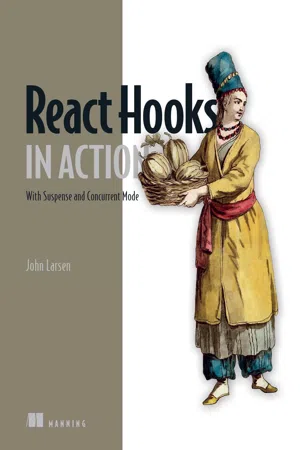
- 376 pages
- English
- ePUB (mobile friendly)
- Available on iOS & Android
About this book
React Hooks in Action teaches you to write fast and reusable React components using Hooks. Summary
Build stylish, slick, and speedy-to-load user interfaces in React without writing custom classes. React Hooks are a new category of functions that help you to manage state, lifecycle, and side effects within functional components. React Hooks in Action teaches you to use pre-built hooks like useState, useReducer and useEffect to build your own hooks. Your code will be more reusable, require less boilerplate, and you'll instantly be a more effective React developer. About the technology
Get started with React Hooks and you'll soon have code that's better organized and easier to maintain. React Hooks are targeted JavaScript functions that let you reuse and share functionality across components. Use them to split components into smaller functions, manage state and side effects, and access React features without classes—all without having to rearrange your component hierarchy. About the book
React Hooks in Action teaches you to write fast and reusable React components using Hooks. You'll start by learning to create component code with Hooks. Next, you'll implement a resource booking application that demonstrates managing local state, application state, and side effects like fetching data. Code samples and illustrations make learning Hooks easy. What's inside Build function components that access React features
Manage local, shared, and application state
Explore built-in, custom, and third-party hooks
Load, update, and cache data with React Query
Improve page and data loading with code-splitting and React Suspense About the reader
For beginning to intermediate React developers. About the author
John Larsen has been a teacher and web developer for over 20 years, creating apps for education and helping students learn to code. He is the author of Get Programming with JavaScript. Table of Contents PART 11 React is evolving2 Managing component state with useState hook3 Managing component state with useReducer hook4 Working with side effects5 Managing component state with useRef hook6 Managing application state7 Managing performance with useMemo8 Managing state with the Context API9 Creating your own hooks10 Using third party hooksPART 211 Code splitting with Suspense12 Integrating data-fetching with Suspense13 Experimenting with useTransition, useDeferredValue and SuspenseList
Frequently asked questions
- Essential is ideal for learners and professionals who enjoy exploring a wide range of subjects. Access the Essential Library with 800,000+ trusted titles and best-sellers across business, personal growth, and the humanities. Includes unlimited reading time and Standard Read Aloud voice.
- Complete: Perfect for advanced learners and researchers needing full, unrestricted access. Unlock 1.4M+ books across hundreds of subjects, including academic and specialized titles. The Complete Plan also includes advanced features like Premium Read Aloud and Research Assistant.
Please note we cannot support devices running on iOS 13 and Android 7 or earlier. Learn more about using the app.
Information
Table of contents
- React Hooks in Action
- Copyright
- dedication
- contents
- front matter
- Part 1
- 1 React is evolving
- 2 Managing component state with the useState hook
- 3 Managing component state with the useReducer hook
- 4 Working with side effects
- 5 Managing component state with the useRef hook
- 6 Managing application state
- 7 Managing performance with useMemo
- 8 Managing state with the Context API
- 9 Creating your own hooks
- 10 Using third-party hooks
- Part 2
- 11 Code splitting with Suspense
- 12 Integrating data fetching with Suspense
- 13 Experimenting with useTransition, useDeferredValue, and SuspenseList
- index